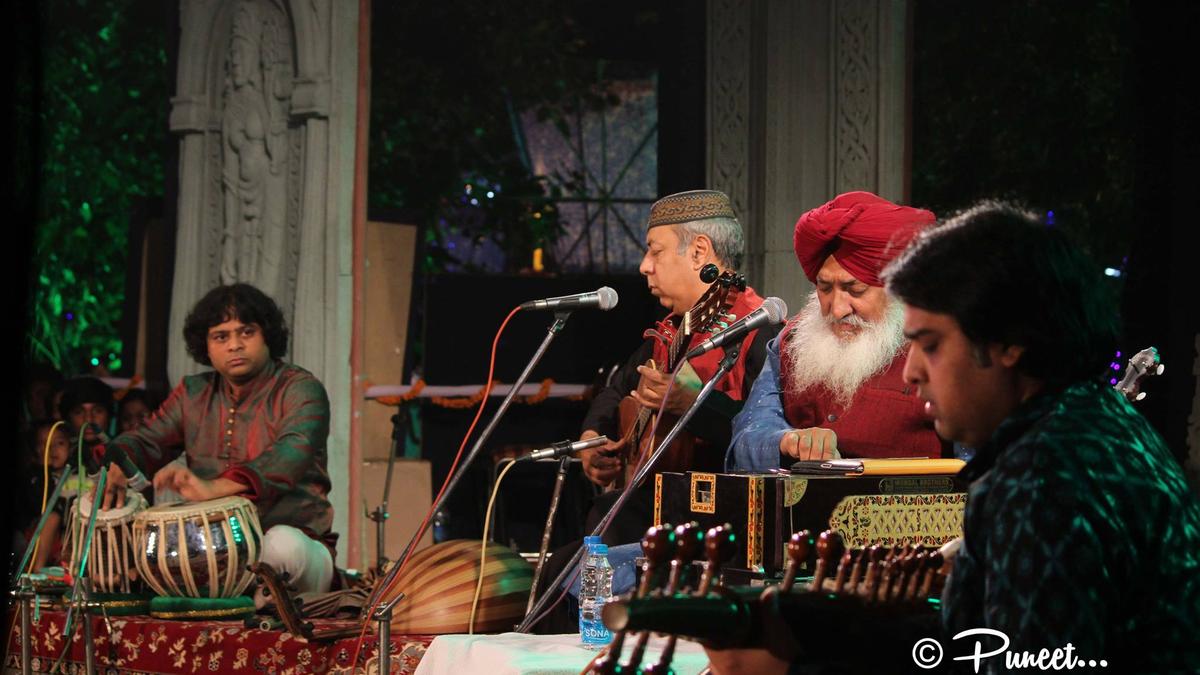
Chaar Yaar is a band driven by friendship and love
The Hindu
Chaar Yaar, an ensemble that looks at the realities of life through music
The music of the Chaar Yaar Ensemble demonstrates how difference need not be a big deal. It’s not just the religious identities of the band members that often finds mention. Nor that they sing medleys blending Kabir with the Beatles, or Bertolt Brecht with Bulleh Shah. The four musicians casually dip into multiple musical genres, creating a melange of songs that are as pleasing as thought-provoking.
The songs the Ensemble presented at the Sacred Spirit Festival in Jodhpur, were born in diverse socio-political and cultural contexts. They conveyed merriment and mysticism. Images of bliss or “the dance of the intoxicated”; of clay jumping on the potter’s wheel; of a world in which “there’s nothing to kill or die for, and no religion too” filled the air when Madan Gopal Singh, Deepak Castelino, Pritam Ghosal and Amjad Khan performed at Chokhelao Bagh (once a fruit orchard on the sprawling premises of the Mehrangarh Fort). Their set-list merged literature, poetry, philosophy, music and theatre, with no trace of heaviness.
Chaar Yaar’s genesis begins in friendship, deep engagement with social justice values, Sufi poetry and turbulent politics. Madan Gopal and the late Safdar Hashmi (founder of street-theatre group Jana Natya Manch) met through Safdar’s brother Sohail Hashmi. Both teachers of English Literature, Safdar and Madan Gopal watched politically charged plays and faced the hard times of Emergency together. Later, it was Safdar Hashmi who ordered Madan Gopal to come over and listen to cassettes that Sohail had brought from Pakistan.
Madan Gopal was so moved by the voices of Tufail Niazmi and Allan Fakir that he had to take many breaks while listening to them. “They shaped my musical journey. Tufail more so, because of the language affinity,” says Madan Gopal. As he listened to the music, Safdar Hashmi plied him with cups of tea and cooked him a meal. “Safdar saw that I was emotionally distraught. He packed the cassettes and handed them to me,” recalls Madan Gopal. They were played on loop in Madan Gopal’s household for months thereafter, his family sharing the passion for both – music and immersive listening.
“I started singing Heer Ranjha because I heard Tufail Niazmi and that was only because of Safdar Hashmi,” says Madan Gopal. Later, “the universe conspired” to get him to sing with Tufail Niazi, Allan Fakir and Iranian Sufi singer Shahram Nazeri (whose voice he had fallen in love with). Before that came his foray into street-theatre as a sutradhar for Safdar Hashmi’s plays during the rise of militancy in Punjab. He later sang for theatre, art films and at social gatherings in Delhi households (with his painter-friend Manjit Bawa, accompanying him on a hand drum or dholak). At one such gathering, Madan Gopal met Deepak Castelino, a guitarist and jazz musician.
The musical collaboration that began three decades ago led to the formation of Chaar Yaar, with Pritam Ghosal joining them on the sarod after a decade, and Amjad Khan joining them on the tabla after another. Deepak says they “experimented with different sounds, trying the flute and sarangi before narrowing down on these four”. He adds that they mostly play their own compositions and translations by Madan Gopal. He recalls offering workshops to children in rural Orissa and Kashmir in the early years.
As a band, their music is associated with not just entertainment but also protest marches and peace-building initiatives. Each of them holds an independent musical practice besides their work with the band.

 Run 3 Space | Play Space Running Game
Run 3 Space | Play Space Running Game Traffic Jam 3D | Online Racing Game
Traffic Jam 3D | Online Racing Game Duck Hunt | Play Old Classic Game
Duck Hunt | Play Old Classic Game











